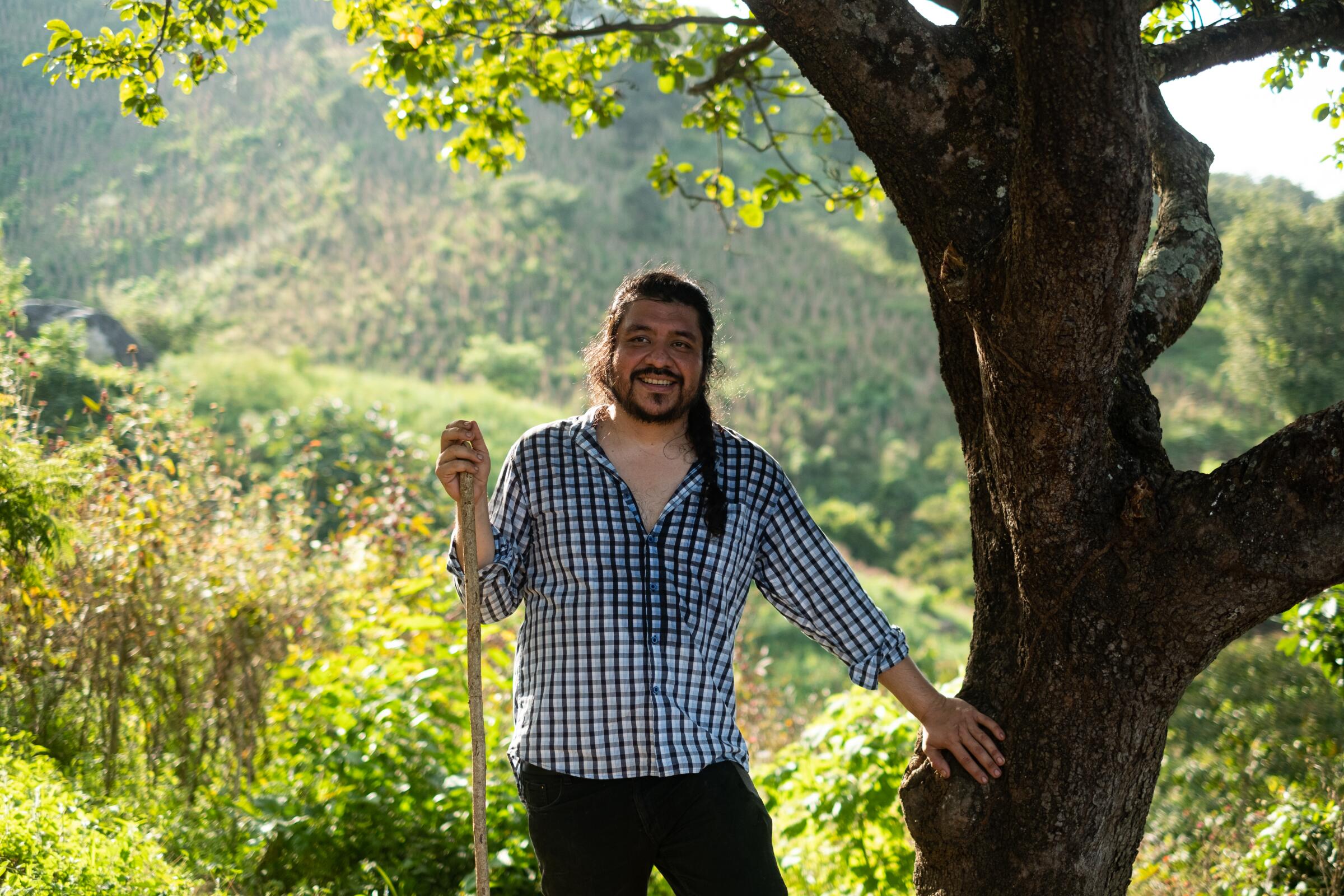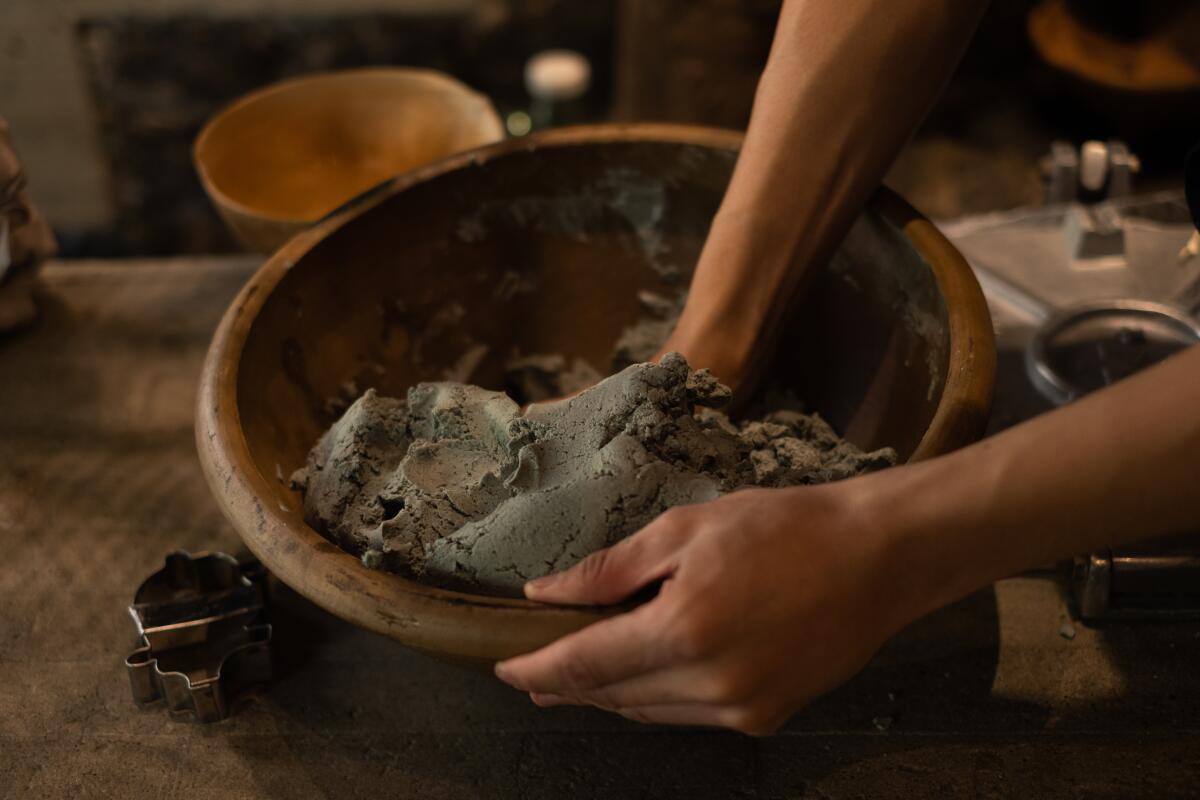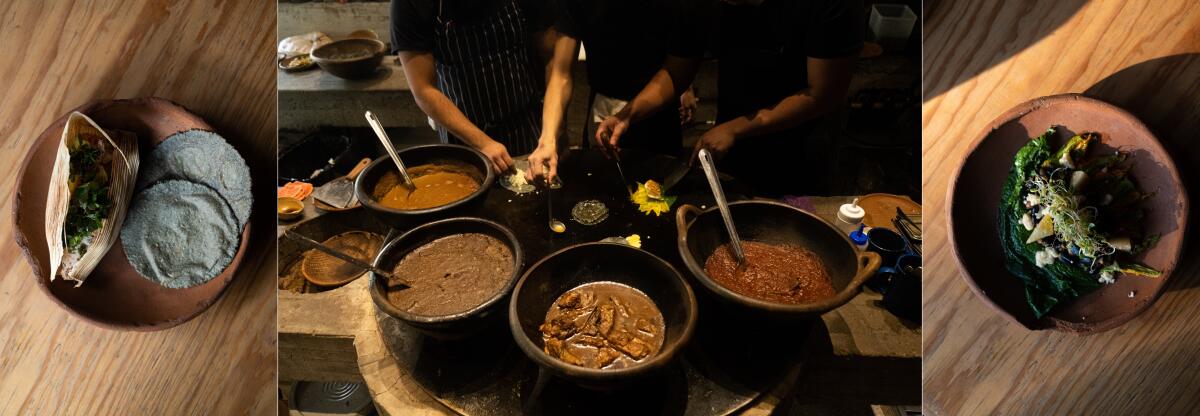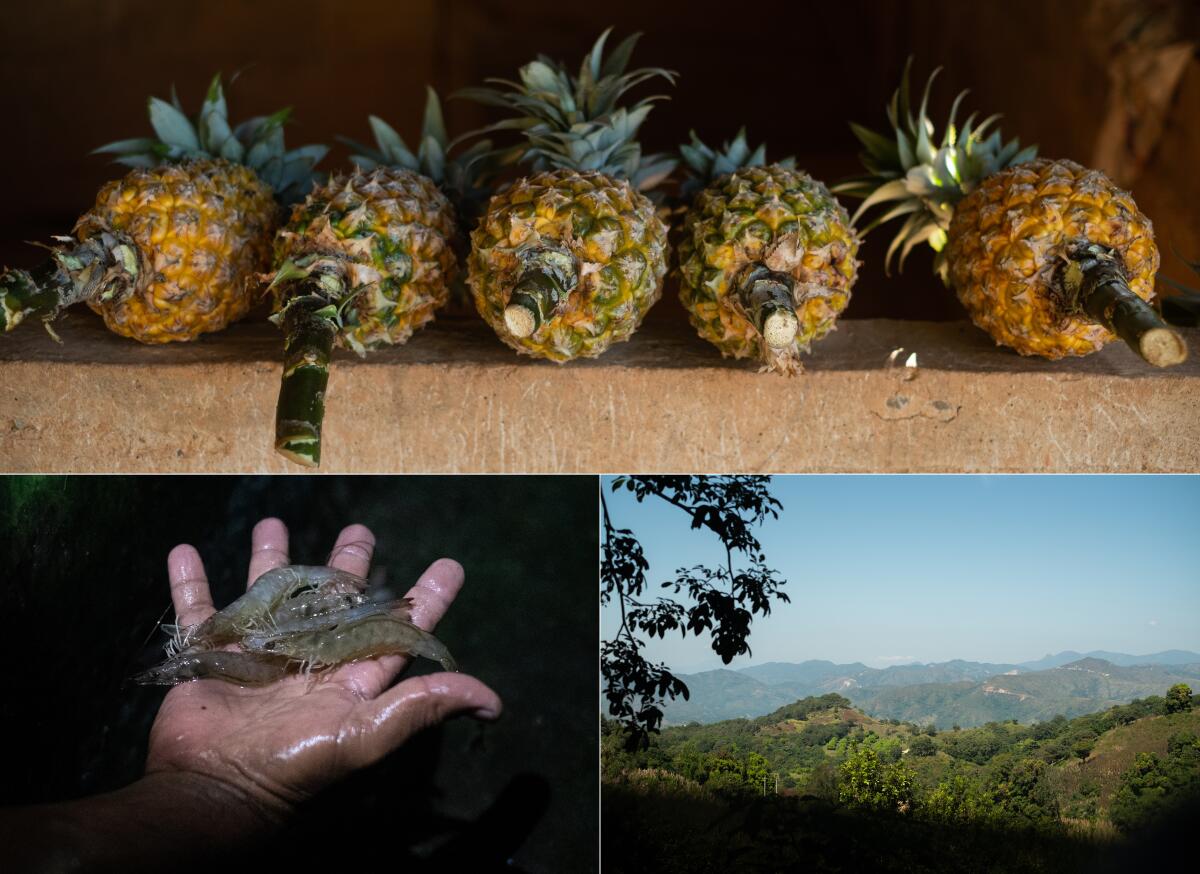Newsletter
Eat your way across L.A.
Get our weekly Tasting Notes newsletter for reviews, news and more.
You may occasionally receive promotional content from the Los Angeles Times.

When Expendio de Maíz opened in April 2018 in the tony Mexico City neighborhood of La Roma, it had neither a sign nor a dining room, just a long, narrow kitchen of concrete and volcanic stone that opened onto the sidewalk and a handful of benches around low, rickety tables. Piles of papayas and bananas in unfamiliar shapes and colors leaned against glass jugs of mezcal, all brought by the chef Jesús Salas Tornés, 33, from his hometown of Ayutla de los Libres in the southwestern state of Guerrero, a region that he refers to only as “mi tierra” — my land.
The food, like the kitchen, was concertedly rural. Bubbling away in clay cazuelas were dishes including mole de queso, salty curds of fresh cheese half melted into a thick red sauce nutty with chile costeño, and mole de platano, bananas in a sweet-sour sauce of onions, garlic, chiles and tomatoes, like Mughlai court cooking by way of the Caribbean.
In a special bonus episode of ‘Off Menu,’ Food columnist Lucas Kwan Peterson goes to Mexico City to sample a variety of Mexican food.
Tornés, who uses his maternal surname (he’s never had a relationship with his father), is a gentle giant with a messy tumble of long black hair and the huge melancholic eyes of a saint. In the first year of the restaurant’s existence, he spent hours hunched over his black stone metate, grinding corn that he nixtamalized on site into a fragrant masa to be shaped into tortillas or sold by the kilo.
He was, at the time, one of few people in the city’s central neighborhoods selling heirloom-corn masa, still widely seen as a luxury product in the capital, where most tortillas are made from the industrial corn flour Maseca.
“I’m convinced that the whole problem in Mexico’s food system comes from our inability to value things as they are,” he says. “The question is simple: How much do you value a tortilla?”

Though invariably revelatory, eating at Expendio was an exercise in patience — you ate what Tornés wanted you to eat at the pace he wanted to serve it: It was, and is, a place of both devotional seriousness and joyful informality.
Even for people who knew about the rich diversity of Mexico’s regional cuisines, the flavors coming out of Tornés’ kitchen were unfamiliar: There were rajas (thin strips of green poblano chile) cooked in coconut oil and a briny shrimp mole and a banana-stuffed enchilada bathed in a pale mole of pine nuts and white cacao, a dish, Tornés says, that he’s made only once.
Equally unfamiliar was the story Tornés told about his homeland. Ayutla, just inland from the Pacific coast, is best known today as the home of Guerrero’s notorious autodefensas, a network of community police forces that emerged in 2012 after years of escalating drug violence. Though some of the autodefensas have succeeded in restoring a kind of order to their communities, many others have since succumbed to the same systems of corruption and exploitation that they were meant to combat.

At Expendio, Tornés drew his guests into long, meandering conversations (over the course of many such meals and conversations, he and I have become friends) about Ayutla’s remarkable diversity. He talked about the Afro-Mexican communities who fish along the coast; about the dozens of varieties of bananas and mangoes that arrived there from Asia on the Spanish trading ships that traversed the Pacific between Manila and Acapulco from 1565 to 1815; and about the indigenous Mixteco communities who cultivate them in the tangled, verdant hills.
Restaurants that pay homage to, and often romanticize, the cooking of rural Mexico have been common in the capital at least since Enrique Olvera opened Pujol in 2000, serving his now-legendary bull’s-eye of aged mole on stark white haute cuisine flatware. But no one has ever translated the spontaneity and ordered chaos of a country kitchen to the city so faithfully.
::
Tornés says he learned much of what he knows about cooking in secret. As a child, he followed his grandmother around like a shadow, from the bakery, where she made pan dulce to sell at the local market, to the kitchen, where he watched her nixtamalize corn over an open flame; watched the fluid roll off her wrists as she ground the softened grains into a thick paste; and watched the rotation of her hardened hands as she pressed the masa into tortillas.
Growing up between Ayutla and Mexico City, where his mother, Ángeles, worked for 25 years, Tornés felt alienated everywhere. In the city, classmates bullied him for his slow coastal accent; in Ayutla, his interest in cooking was stigmatized. By 8, he would plead to cook breakfast for Ángeles, who never much liked cooking herself. In the evenings, they would eat at taco stands scattered across Mexico City where, aping his mother’s gregarious nature — Ángeles knows everyone in Ayutla, almost literally — Tornés ingratiated himself to taqueros to learn what he could of their process.
“My first school was in the streets of Mexico City,” he says. “That’s where I learned to value popular culture.”
Tornés didn’t begin to value the culture of Ayutla, though, until he moved to Puebla for culinary school in 2007. For his five years as a student, he lived on 100 pesos per day, cooking with inexpensive ingredients from the Mercado Miguel Hidalgo and biking out to surrounding villages each weekend rather than spend money eating in town.
“I always felt more comfortable in rural communities, and going out on my bike, I realized how good it felt to be in those places, and that’s when I started to recuperate the rural part of my identity,” he says. “People would ask where I was from and I would say Mexico City. But then, with time, I started feeling proud to say that where I was from and what I knew was Guerrero.”
In April 2011 the people of Cheran, an indigenous Purhepecha community in Michoacan, Mexico, took up arms to expel the illegal loggers who had decimated their forests. In the years since, the wild mushrooms that had gradually disappeared through decades of deforestation have returned.
That part of his identity has since become the basis of his livelihood through the company he founded with his mother — called Siva de Metate, Mixteco for chocolate ground on a metate. Siva de Metate imports ingredients farmed around Ayutla, first to Puebla and then to Mexico City, where he moved in 2012.
Siva de Metate sold sheaves of hoja santa the color of fresh-cut grass and tiny spring onions called tikuchi, delicate as chives and piquant as young garlic, from the Morales family in Tepuente; purple corn and red-seeded long beans from Aurelia García Morales, who’d struggled to preserve the ancestral varieties cultivated by her father after his murder on the family’s plot in 2003; sweet, barbed pineapples that grow like wild agave on the steep hillsides of La Curtina; shrimp from the shallow coastal lagoon near Chautengo; and sal quemado, or burnt salt — gray as ash, citric as pomelo — harvested in the dry season from the lagoon’s mangrove forests.

Two years later, Siva de Metate opened a stall at a weekly organic market in the La Roma neighborhood. Within a year, it had become a supplier for restaurants such as the old-school institution Nicos; Elena Reygadas’ Italianate Rosetta; Mexico City’s best mezcalería, Bosforo; and the scene-y, family-owned La Roma taquería El Parnita. By 2018, Paulino Martínez Acra, one of the owners of El Parnita, approached Tornés with the idea of opening a restaurant in a narrow slip of a space that had opened up next to his restaurant, where Tornés could showcase not only the ingredients of his homeland but also its traditions.
::
Tornés transforms the recipes of his childhood with a puritanical zeal for regional ingredients. Families on the coast might grill their fish with a thick coat of jarred mayonnaise and a slurry of salsa made with bright red tomatoes and serrano chiles grown in Puebla; he makes his with homemade mayo and a salsa of pale, pockmarked heirloom tomatoes and semi-domesticated chiles, smaller and sharper than thumbtacks. Tornés’ Aunt Susana, whom he calls the best cook in the family, makes his favorite dish — mole de olla served with sweet steamed bananas for dipping — with dried guajillo chiles; he might make his with a local variety called mirasol.
“We’re not doing anything innovative,” he says. “For me, it’s about making food from the region through respect for the ingredients from the region.” The result at Expendio was a rural cooking less obsessed with “authenticity” than with reading food as a historical text.

Ana Gonzalez, who was born and raised in the same southern district of Mexico City where Tornés spent much of his childhood, took over as Expendio’s lead cook in April so he could focus more on the supply side of his business. She started introducing her own dishes to the menu not long after joining the kitchen as a cook a few months prior. Some, such as a taco piled extravagantly with whole kernels of nixtamalized corn, have since become signature dishes. Gonzalez describes it as her variation on a taco de aire, a dish from the north that consists of a tortilla folded over and deep fried — like a taco dorado with nothing inside — “where the nixtamal itself is the filling,” she says. “I want nixtamalized corn to be valued as an ingredient on its own.”
Since opening, Expendio has become less chaotic (thanks largely to Gonzalez’s influence) and more popular, particularly with foreigners. When it first opened, Expendio went through about 400 kilos of nixtamalized corn every month; now, it’s more than 10,000 kilos, Tornés says. Both Tornés and Gonzalez would like to see their clientele shift toward a more even balance between locals and visitors but, Gonzalez says, “Lots of people from here will come and say, ‘Why would I pay 85 pesos for a taco?’ We want to kill that stigma.”
“In some ways, it’s like we’re still living at the beginning of the 20th century,” Tornés says, “when people preferred to be seen eating French food and would eat their tortillas in private.”
It’s a problem, he says, that requires changes at both ends of Mexico’s supply chain: a reduction in the number of exploitative middlemen between farmers and consumers, the reeducation (to use a term favored by Guerrero’s autodefensas) of urban people to see indigenous foodways not as cheap or backward, nor as simplified nationalist symbols to brandish when convenient, but as a complex cultural inheritance worthy of study and respect. These ideas are no more innovative than Tornés’ cooking; they’re also no less essential.
Eat your way across L.A.
Get our weekly Tasting Notes newsletter for reviews, news and more.
You may occasionally receive promotional content from the Los Angeles Times.